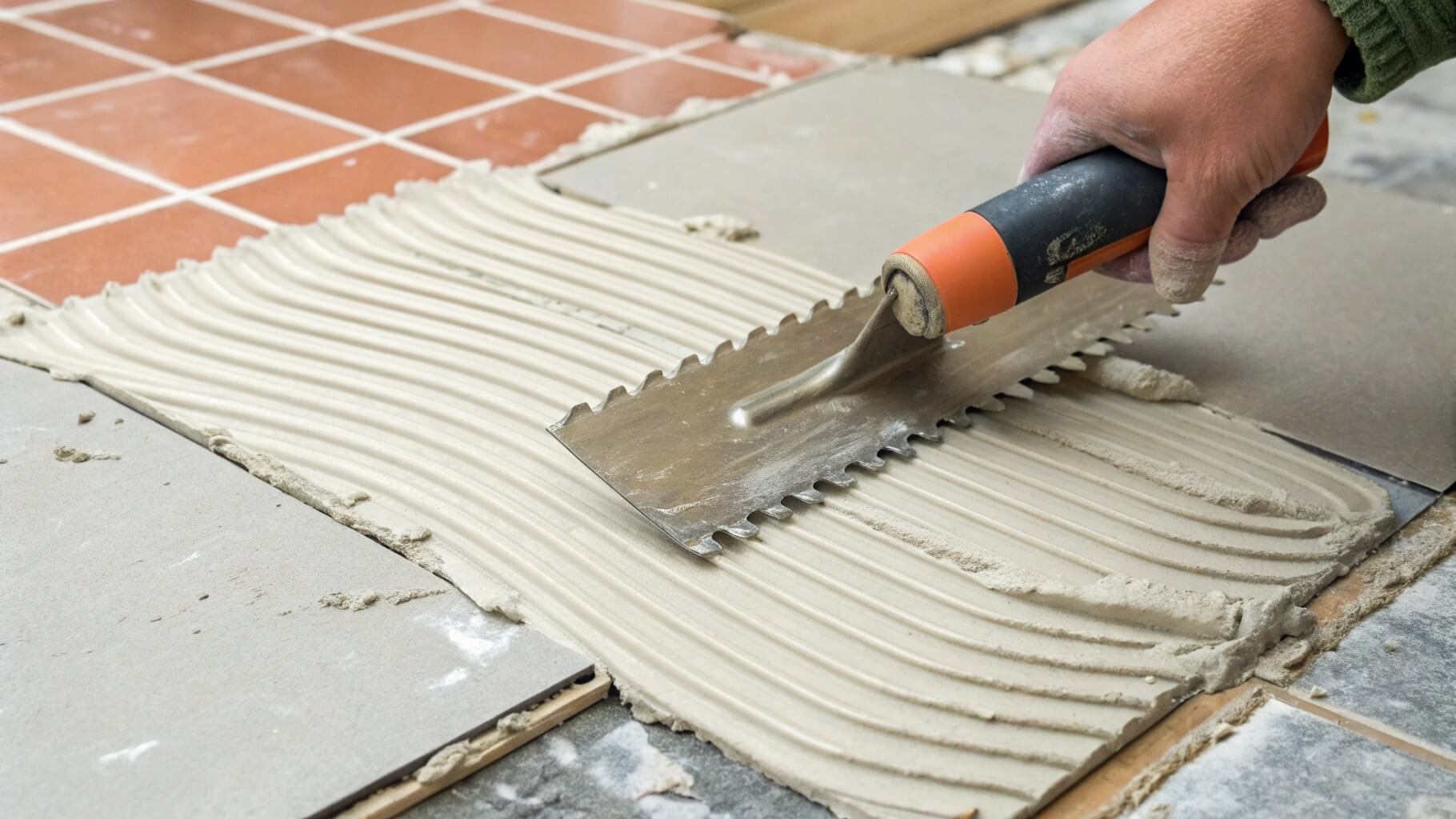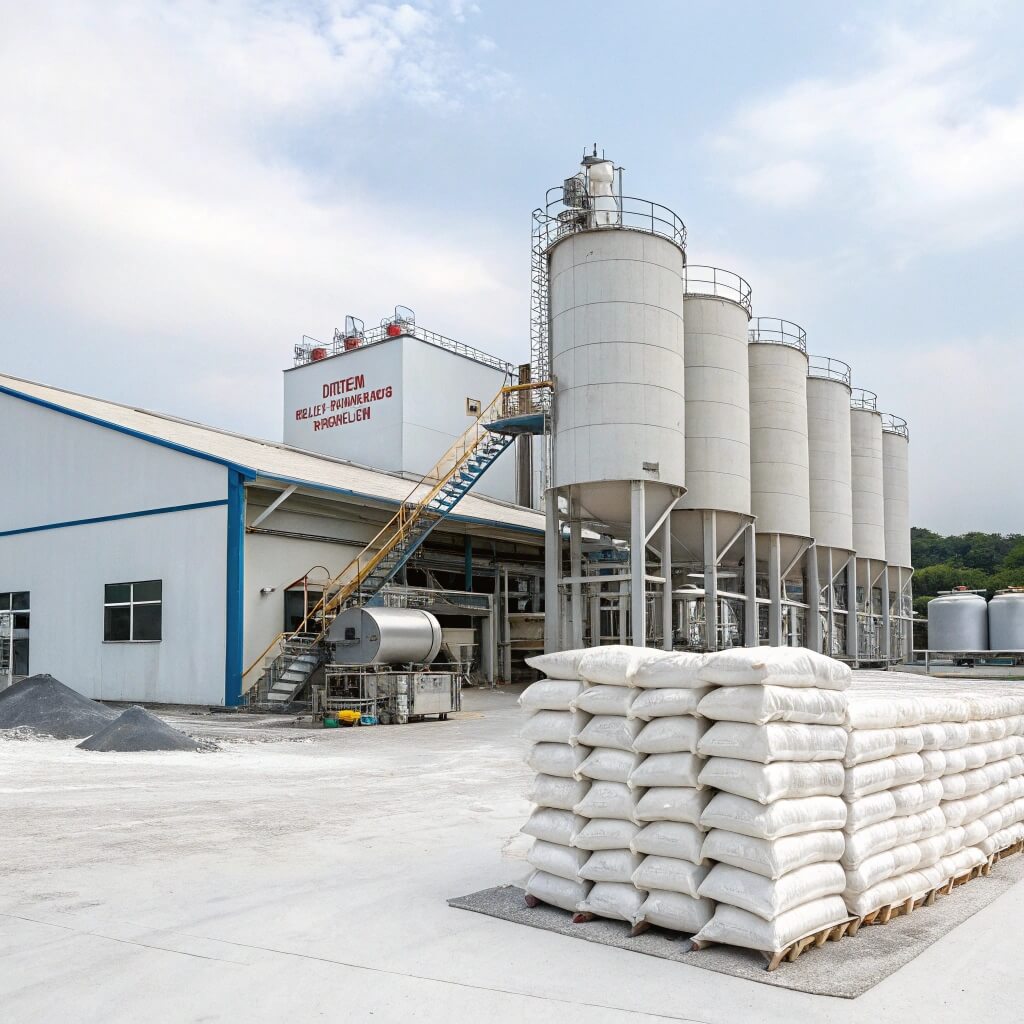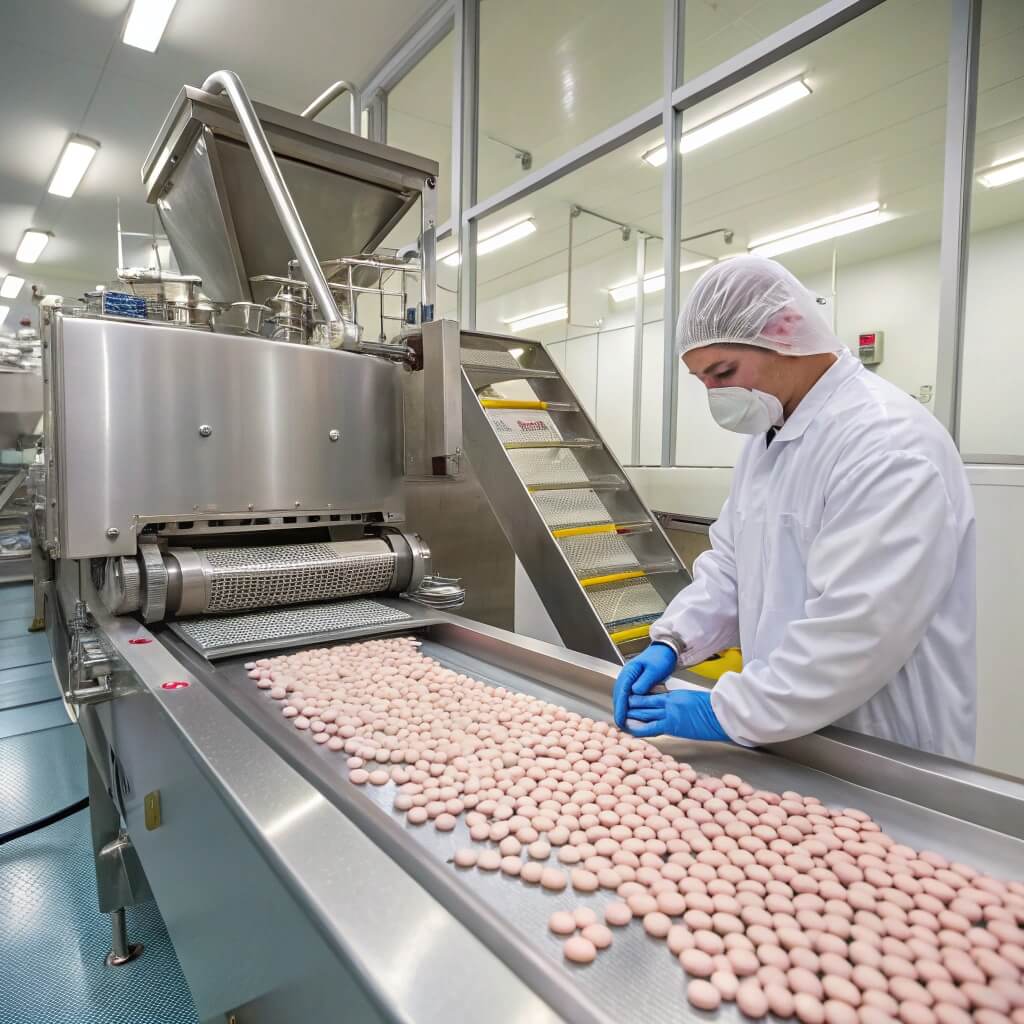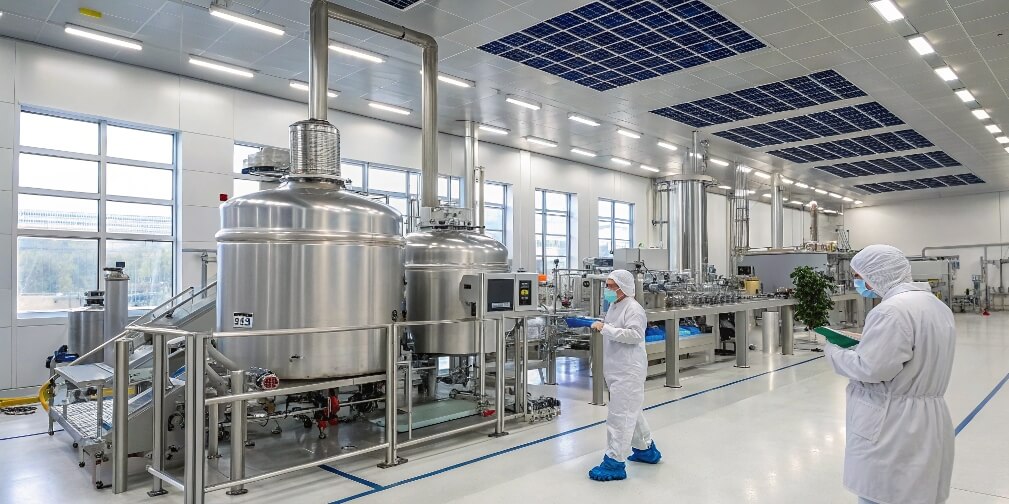Tile adhesive failures can lead to cracked tiles, weak bonding, and costly repairs. Choosing the right formulation is crucial for durability and performance. But what makes Hydroxypropyl Methylcellulose (HPMC) an essential ingredient in tile adhesives?
HPMC is a critical additive in tile adhesives, enhancing water retention, workability, and adhesion strength. It prevents premature drying, improves spreadability, and ensures strong bonding between tiles and substrates. Without it, tile adhesives may dry too quickly, weakening adhesion and leading to installation failures.

Image Description: A close-up of tile adhesive being spread on a surface, showcasing smooth application and proper consistency.
While many additives can enhance tile adhesives, HPMC stands out for its unique ability to balance open time, slip resistance, and moisture retention. In the next sections, we’ll explore its role, benefits, and how it compares to alternative additives in tile adhesive formulations.
What is HPMC and Why is it Used in Tile Adhesive?
Tile adhesives need consistent performance to ensure strong bonding, but poor water retention and weak adhesion can cause tiles to detach over time. How does Hydroxypropyl Methylcellulose (HPMC) solve this problem?
HPMC is a cellulose-derived polymer that enhances water retention, workability, and adhesion in tile adhesives. It prevents premature drying, allowing proper hydration of cement-based formulations. This ensures strong bonding and extends open time for tile adjustments.
Understanding HPMC in Tile Adhesives
HPMC is a non-ionic, water-soluble polymer derived from natural cellulose. It is commonly used in cement-based tile adhesives to enhance their performance. The key functions of HPMC in tile adhesives include:
- Water Retention – Prevents rapid water loss, ensuring proper cement hydration.
- Workability Improvement – Enhances spreadability and consistency of the adhesive.
- Slip Resistance – Prevents tiles from shifting after placement.
- Open Time Extension – Provides more time for tile positioning before setting.
- Improved Adhesion Strength – Enhances bonding between tiles and substrates.
Chemical and Physical Properties of HPMC
| Property | Impact on Tile Adhesive |
|---|---|
| Water Solubility | Easily dissolves in water, ensuring even distribution in the mix. |
| Viscosity | Determines the thickness and workability of the adhesive. |
| Film-Forming Ability | Enhances adhesion strength and prevents cracks. |
| pH Stability | Compatible with cement-based systems. |
| Thermal Gelation | Provides stability at different temperatures. |
HPMC acts as a rheology modifier, improving the consistency and application of tile adhesives. Without HPMC, adhesives may dry too fast, leading to weak bonding and improper tile installation.
HPMC’s role in tile adhesives is foundational, but how exactly does it improve their performance? Let’s explore its impact on adhesion strength, setting time, and overall workability.
How Does HPMC Improve Tile Adhesive Performance?
Tile adhesive failures often stem from poor water retention, weak adhesion, and inadequate workability. These issues can lead to detachment, cracking, or improper tile positioning. So, how does Hydroxypropyl Methylcellulose (HPMC) enhance tile adhesive performance[^1]?
[^1]: Understanding the factors affecting tile adhesive performance can help in selecting the right products for your projects.
HPMC optimizes tile adhesive by improving water retention, workability, adhesion strength, and slip resistance. It ensures prolonged open time, prevents premature drying, and enhances spreadability for efficient tile installation.
Key Ways HPMC Enhances Tile Adhesive Performance
1. Water Retention for Proper Cement Hydration
HPMC prevents rapid water evaporation from the adhesive, allowing cement particles to fully hydrate. This ensures optimal strength development and reduces the risk of tile detachment.
- Without HPMC: The adhesive dries too quickly, weakening the cement bond.
- With HPMC: Moisture remains longer, improving bonding and durability.
2. Improved Workability and Spreadability
HPMC modifies the viscosity of tile adhesive, ensuring a smooth, uniform consistency. This makes it easier to apply, reducing the effort required for spreading.
- Provides a creamier texture, preventing clumping.
- Ensures uniform thickness, improving adhesion strength.
- Reduces sagging, allowing tiles to stay in place after positioning.
3. Extended Open Time for Tile Adjustments
HPMC extends the adhesive’s open time, meaning installers have more time to adjust tiles before the adhesive sets. This prevents rushed applications and misalignment.
- Standard open time without HPMC: 10–15 minutes.
- Extended open time with HPMC: 30–45 minutes (depending on formulation).
4. Enhanced Adhesion Strength and Cohesion
HPMC acts as a binding agent, improving the cohesion between cement and tile surfaces. This prevents delamination and increases bonding strength.
- Stronger adhesion to substrates like concrete, gypsum, and drywall.
- Increased tensile strength, preventing tile movement over time.
5. Slip Resistance for Vertical Tile Applications
When installing wall tiles, slippage is a common issue. HPMC increases the thixotropy of the adhesive, meaning it maintains its shape under stress while remaining easy to spread.
- Reduces tile sliding down during vertical installations.
- Ensures precise alignment without needing spacers.
Performance Impact of HPMC in Tile Adhesives
| Performance Factor | Without HPMC | With HPMC |
|---|---|---|
| Water Retention | Poor, causing weak bonds | High, ensuring full cement hydration |
| Workability | Uneven and hard to spread | Smooth and easy to apply |
| Open Time | Short, requiring fast work | Extended, allowing adjustments |
| Adhesion Strength | Weaker bonding | Stronger, long-lasting adhesion |
| Slip Resistance | Low, causing tile movement | High, keeping tiles in place |
HPMC plays a critical role in optimizing tile adhesives, ensuring efficient application and long-term durability. But what specific benefits does it offer beyond performance improvements? Let’s examine its advantages for contractors, manufacturers, and end-users.
What Are the Main Benefits of HPMC for Tile Adhesive?
Tile adhesives must balance workability, adhesion strength, and durability to ensure a long-lasting bond. Without proper additives, adhesives may dry too quickly, weaken over time, or fail to hold tiles in place. So, why is Hydroxypropyl Methylcellulose (HPMC) a preferred choice?
HPMC enhances tile adhesives by improving water retention, workability, adhesion strength, open time, and slip resistance. It ensures a smooth application process while maintaining long-term durability and bonding strength.
Key Benefits of HPMC in Tile Adhesives
1. Superior Water Retention for Better Hydration
One of the most critical functions of HPMC is its ability to retain water within the adhesive mixture. This ensures that cement particles hydrate fully, preventing early drying and weak bonding.
- Extends working time by 30–50% compared to formulations without HPMC.
- Ensures better adhesion strength by allowing complete cement curing.
- Reduces the risk of shrinkage cracks caused by moisture loss.
2. Improved Workability and Consistency
HPMC acts as a rheology modifier, giving tile adhesives a smooth, creamy texture that is easy to spread. This reduces the physical effort required for application.
- Prevents lumps and clumps, ensuring uniformity.
- Allows easier troweling, reducing fatigue for installers.
- Improves flow properties without excessive water addition.
3. Extended Open Time for Precise Tile Placement
HPMC significantly increases the open time of tile adhesives, giving installers more flexibility to adjust tiles before the adhesive starts setting.
- Standard adhesives: 10–15 minutes of open time.
- HPMC-enhanced adhesives: 30–45 minutes, depending on dosage.
This reduces waste, prevents rushed installations, and allows corrections without compromising bond strength.
4. Stronger Adhesion for Long-Lasting Tile Installations
HPMC improves bonding strength between the tile and substrate, ensuring the adhesive holds firm under various conditions.
- Enhances tensile and shear strength, preventing tile detachment.
- Works well on porous and non-porous surfaces like concrete, gypsum, and drywall.
- Reduces failures in high-traffic and moisture-prone areas.
5. Better Slip Resistance for Vertical Applications
Tiles applied on walls or vertical surfaces often slide down due to gravity. HPMC enhances slip resistance, keeping tiles securely in place.
- Ensures better control during wall tile installations.
- Reduces the need for temporary supports or spacers.
- Improves efficiency in fast-paced construction projects.
Comparative Benefits of HPMC in Tile Adhesives
| Benefit | Without HPMC | With HPMC |
|---|---|---|
| Water Retention | Low, causing early drying | High, ensuring full hydration |
| Workability | Difficult to spread | Smooth and easy application |
| Open Time | Short, requiring quick installation | Extended, allowing adjustments |
| Adhesion Strength | Weak bond formation | Strong, long-lasting bonding |
| Slip Resistance | Poor, tiles may shift | Excellent, preventing movement |
HPMC delivers significant advantages for manufacturers, contractors, and end-users, ensuring that tile adhesives remain reliable and efficient. But how does it compare to other additives commonly used in tile adhesives? Let’s break down the differences.
How Does HPMC Compare to Other Additives in Tile Adhesive?
Tile adhesives rely on various additives to enhance performance, but not all ingredients offer the same benefits. While Hydroxypropyl Methylcellulose (HPMC) is a common choice, other materials like starch ethers, redispersible polymer powders (RDP), and cellulose ethers also play a role. How does HPMC stand out?
HPMC surpasses other additives in water retention, workability, and open time extension. While alternatives like starch ethers improve consistency and RDP enhances flexibility, HPMC provides a well-balanced formulation that optimizes adhesion strength, ease of application, and durability.
Comparing HPMC with Other Tile Adhesive Additives
1. HPMC vs. Starch Ethers
Starch ethers are often used in tile adhesives to enhance thickening and improve workability, but they lack the critical water retention and adhesion properties of HPMC.
| Factor | HPMC | Starch Ethers |
|---|---|---|
| Water Retention | High, ensuring cement hydration | Low, leading to early drying |
| Workability | Smooth and consistent | Improves flow but lacks stability |
| Adhesion Strength | Strong bonding to substrates | Limited bonding improvement |
| Open Time | Extended up to 45 minutes | No significant impact |
2. HPMC vs. Redispersible Polymer Powder (RDP)
Redispersible polymer powders are used to increase flexibility and impact resistance, but they do not contribute to water retention or slip resistance like HPMC.
| Factor | HPMC | Redispersible Polymer Powder (RDP) |
|---|---|---|
| Water Retention | High, prevents premature drying | No effect on water retention |
| Workability | Improves trowelability | Enhances flexibility but not flow |
| Adhesion Strength | Strong bonding to tiles | Adds elasticity to the adhesive |
| Open Time | Significantly extended | Slightly extended, but not as much as HPMC |
3. HPMC vs. Other Cellulose Ethers (HEC, CMC, MC)
Other cellulose ethers like Hydroxyethyl Cellulose (HEC), Carboxymethyl Cellulose (CMC), and Methyl Cellulose (MC) share some properties with HPMC but differ in effectiveness.
| Factor | HPMC | Other Cellulose Ethers (HEC, CMC, MC) |
|---|---|---|
| Water Retention | High, essential for curing | Moderate to low retention |
| Workability | Excellent consistency | Less stable viscosity control |
| Adhesion Strength | High bonding power | Varies depending on the type |
| Slip Resistance | Prevents tile movement | Less effective in vertical applications |
Why HPMC is the Best Choice for Tile Adhesive
- Comprehensive Benefits: Unlike starch ethers or RDP, HPMC balances water retention, adhesion strength, and slip resistance in a single additive.
- Versatility: Works across different tile adhesive formulations, from standard to high-performance grades.
- Cost-Effectiveness: Provides multiple benefits without requiring additional stabilizers or thickening agents.
Other additives can enhance specific properties, but HPMC remains the most efficient solution for ensuring reliable, high-performance tile adhesives. Now, let’s explore how to determine the best HPMC grade and dosage for tile adhesives.
What is the Best HPMC Grade and Dosage for Tile Adhesives?
Not all Hydroxypropyl Methylcellulose (HPMC) grades perform the same in tile adhesives. Selecting the right viscosity and dosage is crucial to optimizing workability, adhesion strength, and open time. But how do you determine the best HPMC specifications for your formulation?
The best HPMC grade for tile adhesives typically ranges between 40,000–100,000 mPa·s viscosity, with a dosage of 0.3–0.6% by weight. Higher viscosity grades provide better water retention and slip resistance, while lower viscosity options improve workability.
Choosing the Right HPMC Grade for Tile Adhesives
HPMC is available in different viscosity levels, which influence its effect on tile adhesive properties. Below is a comparison of common HPMC grades and their impact:
| HPMC Viscosity (mPa·s) | Effect on Tile Adhesive | Best Use Case |
|---|---|---|
| 20,000–40,000 | Improves spreadability and flow | Standard tile adhesive |
| 40,000–75,000 | Enhances water retention, extends open time | General-purpose adhesives |
| 75,000–100,000 | Increases slip resistance and adhesion strength | High-performance adhesives |
- Lower viscosity (20,000–40,000 mPa·s): Best for applications requiring easy spreading and high fluidity.
- Medium viscosity (40,000–75,000 mPa·s): Ideal for balanced workability and adhesion.
- High viscosity (75,000–100,000 mPa·s): Provides maximum slip resistance and extended open time, suited for vertical tile applications.
Recommended HPMC Dosage for Tile Adhesives
The correct HPMC dosage depends on the adhesive type and desired performance:
| Tile Adhesive Type | Recommended HPMC Dosage (% by weight) |
|---|---|
| Standard Cement-Based Tile Adhesive | 0.3–0.4% |
| High-Performance Tile Adhesive | 0.4–0.6% |
| Flexible or Modified Adhesives | 0.5–0.7% |
- Lower dosages (0.3–0.4%) improve spreadability and basic water retention.
- Moderate dosages (0.4–0.6%) provide optimal open time and adhesion strength.
- Higher dosages (0.5–0.7%) enhance slip resistance and vertical applications.
Factors Affecting HPMC Selection and Dosage
-
Climate Conditions:
- In hot, dry climates, a higher viscosity HPMC (75,000–100,000 mPa·s) and higher dosage (0.5–0.7%) prevent rapid moisture loss.
- In cooler regions, a medium viscosity (40,000–75,000 mPa·s) and lower dosage (0.3–0.5%) work well.
-
Tile Type and Size:
- Larger tiles require higher viscosity HPMC to prevent sagging.
- Porous tiles need better water retention, so a dosage of at least 0.4–0.6% is recommended.
-
Substrate Absorption Rate:
- Highly absorbent surfaces require higher water retention, so higher viscosity HPMC is preferred.
- Non-porous surfaces like glass tiles may perform better with a lower viscosity grade.
Why Proper HPMC Selection Matters
Choosing the right HPMC grade and dosage ensures:
- Efficient installation with proper workability
- Stronger adhesion and longer durability
- Reduced tile failures and better resistance to environmental conditions
Understanding how to optimize HPMC in tile adhesives is essential, but proper application techniques also play a role. Next, let’s explore best practices for using HPMC in tile adhesive formulations.
How to Ensure the Best Results When Using HPMC in Tile Adhesives?
Even with the right HPMC grade and dosage, improper handling and mixing can reduce its effectiveness in tile adhesives. Issues like inconsistent water retention, poor adhesion, or uneven application can arise if best practices aren’t followed. So, how can you maximize HPMC’s benefits?
To achieve optimal performance, HPMC must be properly dispersed, mixed, and stored under controlled conditions. Factors such as water temperature, mixing time, and ingredient sequencing impact the final adhesive quality.
Best Practices for Using HPMC in Tile Adhesives
1. Proper Mixing and Dispersion
HPMC is a water-soluble polymer, but improper mixing can lead to clumping or inconsistent performance. Follow these steps for effective dispersion:
- Pre-mix HPMC with dry cement powder to ensure uniform distribution.
- Use a slow-speed mechanical mixer to prevent air entrapment.
- Dissolve HPMC in warm water (20–40°C) if pre-hydration is required, avoiding direct addition to hot water.
- Allow adequate hydration time (15–30 minutes) before final application.
2. Control Water-to-Adhesive Ratio
The water-to-adhesive ratio affects consistency, workability, and adhesion strength. Too much water reduces bond strength, while too little shortens open time.
| Factor | Impact of Too Much Water | Impact of Too Little Water |
|---|---|---|
| Workability | Excessively thin, runs off surfaces | Thick, difficult to spread |
| Adhesion Strength | Weakens bonding properties | Incomplete bonding |
| Open Time | Extended but weak setting | Short, requiring rapid tile placement |
Tip: Follow the manufacturer’s recommended water-to-powder ratio, typically 5–6 liters of water per 25 kg of dry adhesive mix.
3. Optimize Open Time and Working Conditions
HPMC extends open time, but environmental conditions also play a role:
- Hot, dry climates: Increase HPMC dosage to prevent premature drying.
- High humidity areas: Reduce HPMC viscosity to maintain proper setting time.
- Windy or sun-exposed sites: Apply adhesives in shaded conditions for stability.
4. Storage and Handling Guidelines
HPMC’s properties degrade if exposed to moisture, extreme heat, or contamination. Proper storage ensures long-term stability:
- Store in sealed, moisture-proof packaging away from humidity.
- Keep at room temperature (15–25°C) to maintain consistency.
- Avoid long-term exposure to direct sunlight, which can alter polymer structure.
5. Testing and Quality Control
Before large-scale production or installation, always test HPMC-enhanced adhesives to confirm performance:
- Conduct slump and adhesion strength tests for vertical applications.
- Check open time under real job-site conditions to adjust formulations.
- Evaluate bonding strength on different tile and substrate types.
Common Issues and Solutions When Using HPMC
| Issue | Cause | Solution |
|---|---|---|
| Poor Workability | Incorrect water ratio | Adjust mixing ratio and time |
| Adhesive Dries Too Fast | Low HPMC dosage, hot conditions | Increase HPMC percentage or use shade |
| Weak Adhesion | Insufficient hydration time | Extend mixing and resting time |
| Tile Slippage on Walls | Low viscosity HPMC | Switch to a higher viscosity grade |
Why Proper Application of HPMC Matters
By following these best practices, HPMC-enhanced tile adhesives will deliver:
- Improved workability and spreadability
- Stronger adhesion and slip resistance
- Longer open time for flexible tile positioning
Selecting the right HPMC grade and dosage is only half the equation—proper handling and application techniques ensure the best results. With everything covered, let’s summarize the key takeaways and next steps.
Conclusion
The performance of tile adhesives depends on a well-balanced formulation that ensures strong adhesion, long open time, and easy application. Among all additives, Hydroxypropyl Methylcellulose (HPMC) plays a crucial role in optimizing water retention, workability, slip resistance, and bonding strength.
Using the right HPMC grade and dosage is essential for achieving consistent results across different tile adhesive applications. A viscosity range of 40,000–100,000 mPa·s and a dosage between 0.3–0.6% are ideal for maintaining stability, durability, and ease of use. However, selecting the best HPMC depends on factors like climate conditions, tile type, and substrate absorption.
Beyond selection, proper mixing, hydration, and application techniques are equally important. Ensuring correct dispersion, controlled water-to-adhesive ratios, and optimized storage conditions will maximize HPMC’s effectiveness. Without these precautions, even high-quality HPMC may fail to deliver the expected performance.
By integrating HPMC into tile adhesive formulations, manufacturers and contractors can achieve:
- Stronger adhesion and longer-lasting installations
- Better workability, reducing installation errors
- Extended open time for more flexibility in tile positioning
- Superior slip resistance for vertical tile applications
Selecting the right HPMC supplier is just as critical as choosing the correct grade. Reliable sourcing ensures consistency, compliance with industry standards, and long-term supply stability. If you’re looking for a high-quality HPMC solution tailored to your tile adhesive needs, reach out today for expert recommendations and customized product options.
FAQ
What is the use of HPMC in tile adhesive?
HPMC is used in tile adhesives to enhance water retention, workability, adhesion strength, and slip resistance. It prevents premature drying, allowing cement to fully hydrate, which improves bonding. HPMC also extends open time, making tile installation easier and reducing the risk of detachment.
What is the best adhesive to use to stick something to a tile?
The best adhesive depends on the type of material being bonded to the tile. Cement-based tile adhesives with HPMC are ideal for ceramic and porcelain tiles. For non-porous surfaces, epoxy-based adhesives provide strong bonding. Silicone or polyurethane adhesives work well for lightweight objects or flexible applications.
What is the function of HPMC coating?
HPMC coatings act as film formers, moisture barriers, and binding agents in various applications. In construction, it improves the durability of coatings. In pharmaceuticals, it controls drug release in tablet coatings. In food, it enhances texture and shelf life.
What is HPMC for Drymix mortar?
HPMC in drymix mortar improves workability, water retention, and adhesion strength. It prevents mortar from drying too quickly, ensuring proper hydration and reducing cracks. HPMC also enhances spreadability, making it easier to apply and improving the final bond strength.




